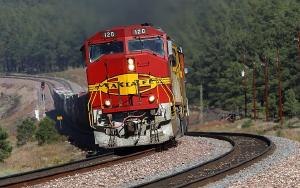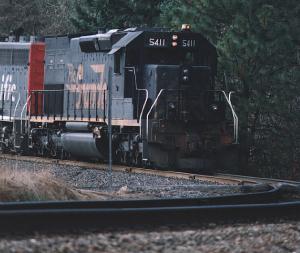The Siskiyou line: Curvature and speed
Curvature is usually given as the reason, why the Siskiyou line is not usable for passenger traffic. Without doubt, there is a problem! Nonetheless, the details are worth looking at.
The worst curvature is found on the Siskiyou Pass. Back in the 1880s, the line from Delta to Ashland was built as one stretch of track, by the same engineers and with the same quality of alignment. Therefore, the curvature is as bad as the curvature in the Sacramento River Canyon, which has to be negotiated by the "Coast Starlight" every day.
Another stretch with lots of tight curvature is Cow Creek Canyon, especially south of West Fork. (West Fork was a railroad, hotel and lumber settlement in that canyon. Like many small settlements along the rails, it is only a location on maps today.) The track in Cow Creek Canyon was built by the "Oregon and California Rail Road", and while it uses the same standard radius for tight curves, the curves have longer spirals on average. This allows more superelevation, and therefore higher speed.

Higher curve speed by matching superelevation needs enough space for the
superelevation runoff.
Curve speed depends on the superelevation of a curve, and on the
unbalanced superelevation allowed
for the train. Theoretically, maximum superelevation is 7 inches in the USA, but this includes the safety margin already.
Practically, 6 inches can be used, or 6.5 inches for well-maintained and frequently inspected track.
These values cannot be used at any location, though. There are legal and practical restrictions.
Legal restrictions, which might rule out high superelevation.
Using high superelevation needs 100 - 250 feet of room on both sides of the curve, because there are safety rules for the minimum length of the superelevation runoff. (Values for various speeds are listed on a separate page.) If this room does not exist, and can't be created by minor realignment, the superelevation of the curve has to be lower. While most of the Siskiyou Line has enough room or something close to that, there are very tight quarters on the Siskiyou Pass itself.
Along the Siskiyou line, standard spiral is the "Railroad Taper", a Southern Pacific invention of 1905. A smaller number of these transitions use the "Searles" curve, which was SP's standard procedure in later times. The old taper of 1905 is based on segments, that are always as long as the 30 foot chord, which was used for creating them. The resulting spirals are 60, 90, 120, 150 feet long, sometimes up to 240. (The Searles curves of later times vary in length.)
Due to the fixed lengths, and due to traditional procedures in the days of manual track maintenance, almost no direct reverse curves are used along the whole Siskiyou line. Instead, a reverse curve will always have a straight section in the middle. Replacement by direct reverse curves, which no longer impose any problem for modern computer-controlled track maintenance machinery, can create longer spirals at many places, thus allowing longer superelevation runoff, more superelevation, and higher speed.
Practical restrictions, which might rule out high superelevation.
"574 feet radius" is the standard tight curve on the Shasta Route. For major parts of the line, current freight speed is 25 mph. Lowest maintenance cost for the track is achieved, if no lateral forces act on the rails. For 574 feet curve radius and 25 mph track speed, this condition needs a superelevation of 4.3 inches. Acceptable forces act on the rails, if the superelevation is set to values between 2.3 and 6.3 inches. These values are right, if the train really operates at 25 mph.

Along the Siskiyou line, Southern Pacific did not superelevate the curves at all, or close to that. This matches the
operating speeds in the last years of a fading-away company: Sometimes, stalled trains had to leave cars behind in sidings.
If the freight operator uses a speed goal of 15 mph uphill, the best superelevation of a 574 feet curve would be 1.5 inches, and acceptable maintenance costs could be reached with values between 3.5 inches and 0. Therefore, lower freight train speed means lower passenger train speed as well, because low freight speeds rule out infrastructure optimization.
Simple conclusion: As long as the freight speeds do not allow the usage of full superelevation, infrastructure investment like curve easing or realignment can be replaced by the application of additional freight loco horsepower: Speed up the freights, raise superelevation, speed up the passenger trains.
For a line with two freight trains per day, replacement of infrastructure investment by freight loco horsepower is a far more interesting consideration than for a line with 20 heavy freights per day (Natron Cutoff). As well, track maintainance to tilting train standards is cheaper by a huge margin under such conditions.
| Curve radius | 574 feet (175 m) | 1910 feet (582 m) |
|---|---|---|
| Standard train, no superelevation of track | 21 mph (34 km/h) | 38 mph (61 km/h) |
| Standard train, 2 inches of superelevation | 27 mph (43 km/h) | 49 mph (79 km/h) |
| Standard train, track fully superelevated | 36 mph (58 km/h) | 66 mph (106 km/h) |
| Cascades Talgo, track fully superelevated | 40 mph (64 km/h) | 73 mph (117 km/h) |
| Talgo fully used, track fully superelevated | 47 mph (75 km/h) | 85 mph (137 km/h) |
If maximum superelevation can be used for most of the Siskiyou Line, and if tilting trains may use 9 or 10 inches of unbalanced superelevation, the Siskiyou Line gets faster than an unimproved Natron Cutoff. While the Natron Cutoff has the advantage of a faster and shorter alignment, it does not allow optimization for passenger train speeds, and has the additional disadvantage of a speed restriction by capacity constraint, as explained on page 31.